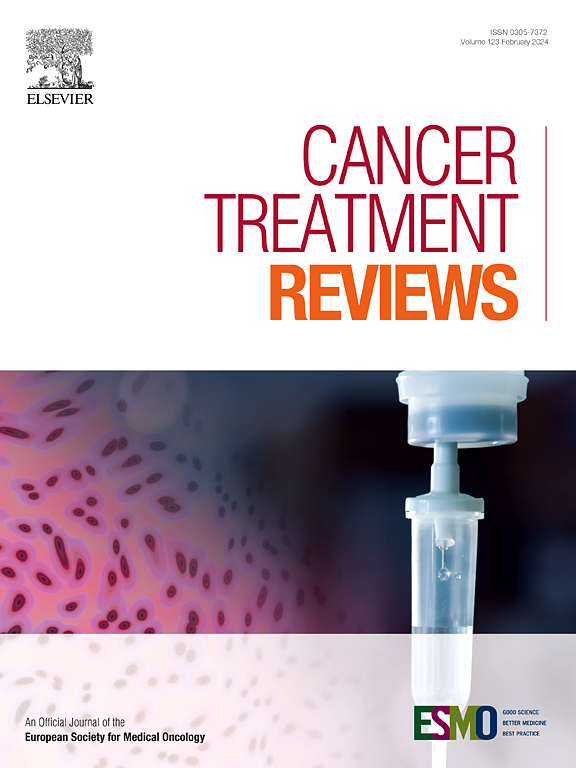妇科恶性肿瘤中与抗体药物结合剂相关的眼部不良事件的实用临床管理方法
IF 9.6
1区 医学
Q1 ONCOLOGY
引用次数: 0
摘要
抗体-药物偶联物(ADC)的出现代表了妇科恶性肿瘤靶向治疗的重大进展。然而,与adc相关的眼部毒性,特别是索妥单抗维多汀(TV)和Mirvetuximab Soravtansine (MIRV),需要有效缓解,以优化患者护理。方法综合临床试验结果,描述adc引起的眼部不良事件。分析的重点是不良事件的发生率、发作、严重程度和可逆性。它检查了潜在的毒性机制,并提供了基于研究方案的管理策略。结果不良反应主要发生在眼前段,引起结膜炎和角膜病变。多达56%接受MIRV治疗的患者和50%至60%接受电视治疗的患者受到影响。视力模糊、干燥和疼痛等症状会影响患者的生活质量。不到10%的病例为CTCAE 3级或以上。中位发病时间为1.3个月。然而,眼毒性可能在治疗开始后10个月出现,表明需要长期警惕。初级预防需要局部皮质治疗、润滑剂,在某些情况下还需要血管收缩剂。尽管可能严重,但大多数病例通过局部治疗和短暂剂量减少和/或延迟治疗是可逆的。密切监测对于早期发现和后续管理至关重要。结论临床医生应认识到adc的潜在眼毒性。积极预防、患者教育和包括眼科医生在内的多学科方法对减少这些不良反应的影响至关重要。进一步的研究对于衡量预防战略的实际结果和平衡其利益与潜在的短期和长期风险是至关重要的。本文章由计算机程序翻译,如有差异,请以英文原文为准。
Practical clinical management of ocular adverse events related to Antibody-Drug Conjugates in gynaecological malignancies
Background
The advent of Antibody-Drug Conjugates (ADC) represents a significant advancement in targeted therapy for gynaecological malignancies. However, the ocular toxicities associated with ADCs, particularly Tisotumab Vedotin (TV) and Mirvetuximab Soravtansine (MIRV) necessitate effective mitigation in order to optimise patient care.
Methods
This review synthesises findings from clinical trials to delineate the spectrum of ocular adverse events induced by ADCs. The analysis focuses on the incidence, onset, severity and reversibility of adverse events. It examines the underlying mechanisms of toxicity and provides management strategies based on study protocols.
Results
Adverse events mainly impact the anterior ocular segment, resulting in conjunctivitis and keratopathy. They affect up to 56 % of patients treated with MIRV and 50 to 60 % of those receiving TV. Symptoms like blurred vision, dryness and pain hinder the patient’s quality of life. Events are CTCAE grade 3 or higher in less than 10 % of cases. The median time to onset is 1.3 months. However, ocular toxicity may appear up to 10 months after treatment initiation, indicating a need for prolonged vigilance. Primary prophylaxis calls for local corticotherapy, lubricants and in some cases, vasoconstrictors. Despite the potential for severity, most cases are reversible with local treatment and transient dose reduction and/or delay. Close monitoring is crucial for early detection and subsequent management.
Conclusions
Clinicians ought to be cognizant of the potential ocular toxicity of ADCs. Proactive prophylaxis, patient education and a multidisciplinary approach involving ophthalmologists are paramount to minimising the impact of these AEs. Further research is essential to measure the real outcome of preventive strategies and balance their benefits with potential short and long-term risks.
求助全文
通过发布文献求助,成功后即可免费获取论文全文。
去求助
来源期刊

Cancer treatment reviews
医学-肿瘤学
CiteScore
21.40
自引率
0.80%
发文量
109
审稿时长
13 days
期刊介绍:
Cancer Treatment Reviews
Journal Overview:
International journal focused on developments in cancer treatment research
Publishes state-of-the-art, authoritative reviews to keep clinicians and researchers informed
Regular Sections in Each Issue:
Comments on Controversy
Tumor Reviews
Anti-tumor Treatments
New Drugs
Complications of Treatment
General and Supportive Care
Laboratory/Clinic Interface
Submission and Editorial System:
Online submission and editorial system for Cancer Treatment Reviews
 求助内容:
求助内容: 应助结果提醒方式:
应助结果提醒方式:


